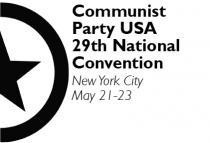 This article is part of the discussion leading up to the Communist Party USA’s 29th National Convention May 21-23, 2010. CPUSA.org takes no responsibility for the opinions expressed in this article or other articles in the pre-convention discussion. All contributions must meet the guidelines for discussion. To read other contributions to this discussion, visit the site of the Pre-Convention Discussion period.
This article is part of the discussion leading up to the Communist Party USA’s 29th National Convention May 21-23, 2010. CPUSA.org takes no responsibility for the opinions expressed in this article or other articles in the pre-convention discussion. All contributions must meet the guidelines for discussion. To read other contributions to this discussion, visit the site of the Pre-Convention Discussion period.
All contributions to the discussion should be sent to discussion2010@cpusa.org for selection not to the individual venues.For more information on the convention or the pre-convention discussion period, you can email convention2010@cpusa.org.
Pre-convention discussion in Connecticut is off to a good start.
At a kick-off state committee meeting the main discussion document was put into the context of our building blocks, the contributions of Marx, Lenin, Dimitrov and Gramsci, which help us analyze the current difficult transitional political terrain. This laid the basis for understanding the main thesis of the document which upholds the necessity of building broad unity against the ultra-right, building the strength of the core forces — labor, racially oppressed, women, youth — and the Communist Party. Building the Party among trade unionists is important, but only part of our responsibility. Building the Party at the grass roots in the broader community gives a bigger world view and gives added meaning for trade unionists to join.
Clubs are reading from the convention discussion workbook and relating the ideas to their own work and experiences. After a few discussions they will put their thinking into writing for submission as contributions to the national discussion.
Groups gathered to watch the first two video broadcasts by Sam Webb and Jarvis Tyner and enjoyed each.
In one discussion following Jarvis Tyner’s video broadcast on the African American equality struggle, someone asked the question, “Taking into account the right-wing attack on Obama, how do we then hold Obama accountable?” In response the point was made that the thrust of Jarvis Tyner’s presentation centered on the need to hold the right-wing accountable, because that is the main source of attack on the working class and people. In the health care struggle, the main obstacle to public option or single payer is not Obama, it is the medical industrial complex entrenched in government and the right-wing Republican political establishment. That’s where our fire should be directed. Our task is to build a movement powerful enough to give momentum to progressive Democrats in Congress and create the climate that moves centrists as well.
Enthusiasm was expressed for Jarvis Tyner’s emphasis on building broad unity and action in this time of economic crisis. A worker in the cultural field expressed the importance of utilizing popular education methods to engage young people in the struggle and share the thinking of the Communist Party. Appreciation was expressed for the approach to African American – immigrant unity, reflecting concrete experiences to build such unity in New Haven.
“I am so glad I came!” was the concluding remark.
The broadcast set the framework for two overflow. multi-racial African American History Month events in Hartford and New Haven with an address by Dr. Gerald Horne on the necessity to preserve and expand affirmative action for the good of all. The New Haven Firebirds, African American firefighters organization, was honored as part of the ongoing work to build unity in counter to the lawsuit of 19 white firefighters claiming reverse discrimination which was heralded by the right-wing and used to try and oppose the appointment of Sonia Sotomayor to the US Supreme Court. The direct connection between affirmative action and jobs for everyone was made.
In one workplace club discussion which centered on the sections “Attitude towards reform” and “Role of the working class” members had the opportunity to think through the inter-relationship of short term and long term goals, and how winning immediate smaller struggles helps lay the basis for bigger more fundamental victories. Examples were considered of new, positive developments in the labor movement that raise class consciousness and open the door to new organizing possibilities.
A club of former industrial workers in the African American community read the section of the main document, “New Normal.” Discussion centered around the fact that “when there are changes at the top, we workers are forced to work for less and bear the brunt.” This was related to club efforts with the Labor Council to build a coalition that can educate and organize enough voice and action to overcome right-wing opposition standing in the way of massive job creation.
Clubs are in the mix as the labor movement begins to unfold the local struggle for jobs connected to the national program. One club is involved around the closing of a grocery store which will leave the community and workers stranded. Another club is involved with its local labor council around the cleanup of a brown-field former industrial site.
A class in Marxism will dovetail with the convention discussion and give grounding to newer members and friends.


 Join Now
Join Now